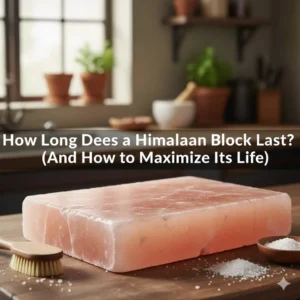Salt blocks can appear to “sweat” in humid environments because salt naturally attracts and retains moisture from the air. Over time, this moisture accumulation can weaken the block’s structure, reduce its performance, and leave surface or surrounding water marks. Understanding this reaction is key to maintaining the integrity and look of your salt products. This guide explains why salt blocks sweat and provides clear, actionable steps to prevent moisture buildup and preserve their durability and aesthetic quality.
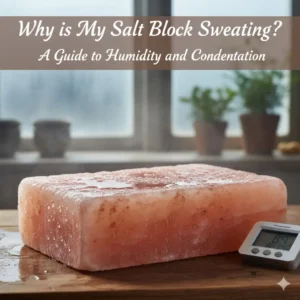
Understanding Salt Block Sweating and Humidity
When a salt block appears wet or “sweating,” it’s responding to the moisture in the air. Salt is hygroscopic, meaning it naturally attracts and absorbs water vapor from its surroundings. In humid environments, this property causes fine droplets or a thin film of condensation to form on the surface.
The reaction becomes more pronounced when warm, humid air encounters a cooler salt block. As the air cools on contact, the vapor condenses, producing the appearance of sweating or weeping—a process similar to condensation forming on a chilled glass in warm weather.

Recognizing this behavior helps you maintain your salt block properly. Sweating isn’t a sign of damage but proof that authentic salt is interacting with ambient humidity. To limit moisture buildup, store the block in a dry, well-ventilated area where airflow and temperature remain steady.
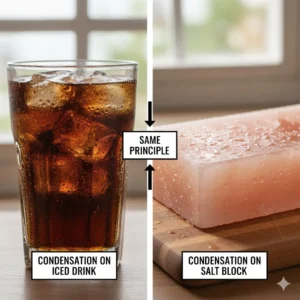
Prerequisites: Tools and Materials
Before addressing a salt block that’s sweating or appears damp, prepare a few essentials. These items help create a controlled, dry environment that reduces moisture absorption caused by humidity or temperature variations. Having them ready ensures the salt block experiences minimal exposure to humid air.
- A clean, breathable container or fully sealed plastic bag
- Soft, dry cloth for removing surface moisture
- Desiccant packets (optional) to capture residual humidity
- A well-ventilated storage location with consistent temperature and low humidity
Assembling these materials in advance allows you to manage environmental moisture effectively, maintain the block’s structural integrity, and prevent surface weeping or damp spots.
Premium Himalayan Salt Blocks for Culinary and Wellness Businesses
Partner with Jilin Ever Creation to access natural pink Himalayan salt products designed for cooking, serving, and brand enhancement. Benefit from flexible customization, private labeling, and global shipping with low minimum orders—ideal for food service, retail, and hospitality sectors.
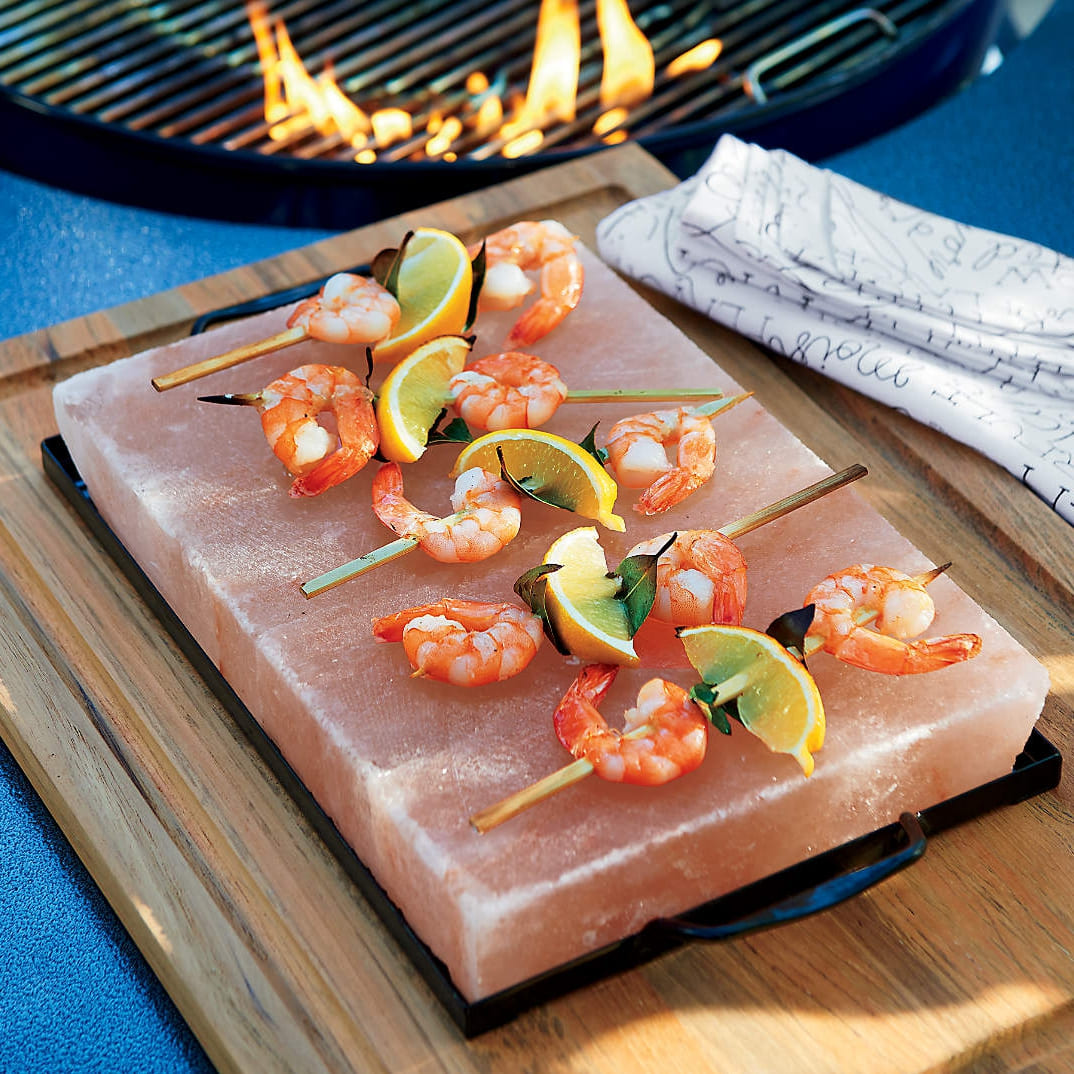
Step 1: Store Salt Blocks in Low-Humidity Areas
Because salt is hygroscopic, it readily absorbs moisture from the air. In humid environments, this interaction can cause visible sweating or weeping as condensation forms on the surface. Storing salt blocks in low-humidity areas minimizes this effect, helping maintain their strength, clarity, and structural integrity.
Choose a cool, dry space—away from kitchens, bathrooms, or basements—where temperature and humidity remain consistent. Avoid locations with frequent temperature shifts or poor ventilation, as these conditions accelerate condensation. Steady airflow supports even drying and reduces surface moisture buildup.
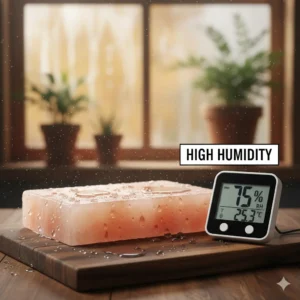
To further protect the block, consider using a dehumidifier or placing silica gel packets nearby. Maintaining a stable, dry environment limits moisture absorption and extends the block’s lifespan for both culinary and decorative applications.
Step 2: Use Sealed Bags or Containers for Protection
Since salt continuously attracts moisture from the air, it’s important to keep your salt block in a controlled environment when not in use. Storing it in an airtight bag or sealed container prevents humid air from reaching the surface and reduces the chance of condensation forming.
Before sealing, ensure the container is completely dry so residual moisture doesn’t cause weeping later. You can add a small desiccant packet to absorb any remaining humidity. When reopening, do so in a low-humidity area to avoid sudden exposure to damp air. Consistent protection preserves the block’s strength, structure, and natural appearance over time.
Step 3: Dry a Sweating Salt Block Safely
When a salt block begins to weep or appear wet, it’s simply responding to humidity in the air. Because salt is hygroscopic, it readily attracts and absorbs moisture. To restore the block without causing damage, handle it carefully and allow it to dry gradually under controlled conditions.
Wipe the surface gently with a dry, soft cloth to remove visible moisture. Place the block in a well-ventilated, low-humidity space where air can circulate freely. Aim for slow, even evaporation to maintain the block’s integrity and smooth surface.
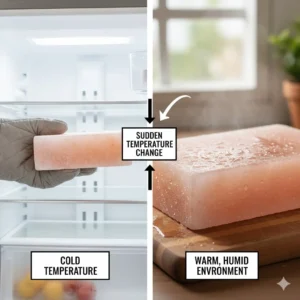
Avoid direct heat or prolonged sunlight exposure, as sudden temperature changes can cause cracking or uneven drying. Once the block feels completely dry, store it in a cool, stable environment to prevent further moisture absorption between uses.
How Salt’s Hygroscopic Properties Affect Maintenance
Salt naturally attracts and releases water vapor from the air. This hygroscopic quality makes a salt block behave like a small dehumidifier, balancing moisture between its surface and the surrounding environment. When humidity increases, condensation can appear as a light sheen or fine droplets on the surface. In drier air, the salt gradually releases that retained moisture back into the atmosphere.
This constant exchange can offer mild environmental benefits by reducing ambient humidity, but it also creates maintenance challenges. The same property that helps absorb moisture can cause the block to soften or degrade if exposed to persistent dampness. Prolonged sweating may lead to surface flaking or minor crumbling, particularly in spaces with limited airflow.
To maintain both the structural integrity and aesthetic quality of salt blocks, store them in a cool, dry location with consistent humidity levels. Wipe away condensation promptly and set them on trays or bases to shield nearby surfaces from moisture. With proper storage, the block’s natural hygroscopic function remains balanced while long-term durability is preserved.
Expert Tips & Common Mistakes to Avoid
Because salt blocks are highly hygroscopic, they readily draw moisture from humid air. Keeping them dry requires storing them in conditions where they have minimal exposure to water vapor. The table below highlights frequent storage and maintenance mistakes alongside practical solutions to prevent sweating, weeping, and surface damage.
| Common Mistake | How to Avoid or Fix It |
|---|---|
| Storing salt blocks in bathrooms or kitchens | Keep blocks in dry, temperature-stable spaces away from steam, sinks, and humidity sources. |
| Using direct heat or sunlight to dry the block | Allow slow, even drying in a ventilated space to prevent cracking from rapid temperature shifts. |
| Leaving blocks exposed for long periods | Seal blocks in airtight containers or bags when not in use to limit exposure to humid air. |
| Ignoring early condensation | Wipe away moisture promptly and inspect for soft spots or surface wear. |
| Using damp cloths for cleaning | Clean only with a dry, soft cloth to prevent dissolving the salt surface. |
Maintaining stable humidity and proper storage conditions is the most effective way to prevent sweating or surface erosion. With consistent care, your salt block will remain solid, attractive, and long-lasting.
Frequently Asked Questions
Is it normal for a salt block to look wet?
Yes. When humidity is high, a salt block can appear wet or “sweating.” Salt is hygroscopic, meaning it draws moisture from the air. The visible dampness is condensation, not structural damage, and indicates the salt is responding naturally to ambient conditions.
What does ‘hygroscopic’ mean when referring to salt?
“Hygroscopic” describes a material’s tendency to absorb water vapor from the surrounding air. Because salt is hygroscopic, it behaves much like a gentle dehumidifier—drawing moisture in humid environments and releasing it as conditions dry out.
Can sweating cause long-term damage to a salt block?
Consistent exposure to moisture can gradually erode or weaken a salt block. As it repeatedly absorbs and releases water, thin surface layers may dissolve. Maintaining airflow and keeping the block dry between uses minimizes this natural wear.
How should a salt block be stored in humid environments?
Store it in a cool, dry location with steady airflow. Setting it on a wooden tray or rack helps air circulate around the base. For extra protection in humid climates, use a sealed container with a desiccant pack to limit moisture contact.
What is the safest way to dry a damp salt block before use?
Allow the block to air-dry completely at room temperature before heating. Avoid ovens, stovetops, or direct sunlight, as sudden temperature changes can cause cracking. Once fully dry, warm it gradually to ensure stable heat distribution.
Final Thoughts
A salt block that appears to sweat or weep isn’t damaged—it’s simply responding to the surrounding humidity. Because salt is hygroscopic, it naturally attracts and absorbs moisture when the air is damp or the block is cooler than its environment. This interaction causes a thin layer of condensation to form on the surface, similar to how droplets appear on a chilled glass.
To maintain your block’s integrity, store it in a dry area or sealed container when not in use. If it becomes damp, gently dry it with a soft cloth and let it rest in a well-ventilated space. Managing humidity and temperature fluctuation prevents structural weakening and surface dullness.
With consistent care and controlled conditions, your salt block will remain sturdy, attractive, and functional for years. A small investment in proper storage goes a long way in preserving both its strength and natural luster.




